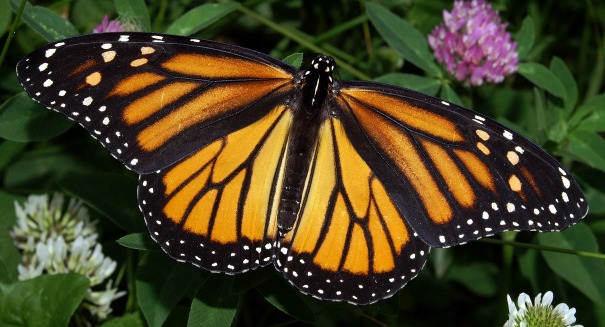
A variety of threats face the monarch butterfly, from deforestation to the loss of its food source, which has caused the population to drop 90 percent in the last 20 years.
The iconic monarch butterfly’s population is tumbling so rapidly that the U.S. Fish and Wildlife Service is considering pointing it on the endangered species list, the agency announced this week.
The monarch population has dropped a stunning 90 percent in the last two decades, according to the Center for Biological Diversity as reported by the Washington Post.
Monarchs are perhaps the best-known butterfly, with its bright orange and black markings, and for their annual migration of thousands of miles from Canada through the United States and into Mexico.
Dwindling milkweed, the monarch caterpillar’s food sources, has been blamed for the decline of the species, as well as threats along the migratory path of the butterflies. Milkweed has fallen victim to pesticides used on corn and soybean farms, a particular problem in the U.S. Midwest.
Severe weather in recent years has also been blamed for problems in the monarch population, along with illegal deforestation in Mexico. The Monarch Butterfly Biosphere Reserve is protected land, but illegal loggers invade it anyway.
In petitions to the Fish and Wildlife Service, advocates argue that it is essential to take steps to protect the iconic species, comparing losing the species to destroying a rare painting, and noting that millions of schoolchildren have learned about nature through watching the metamorphosis of a monarch caterpillar into a butterfly. It is also the official state butterfly of seven states.
What comes next is a year-long review of the petition to include the butterfly in the endangered species list, beginning with a 60-day information gathering process. The Fish and Wildlife Service will be gleaning information on population trends, genetics, distribution patterns, and past conservation measures, among other things.
There are three potential courses of action once the review is complete. The first would be to take no action if it is determined the butterfly doesn’t need protection. The second would be to grant the species protection under the Endangered Species Act. A final option would be to place it on a waiting list, meaning that the agency would find that there are threats to the butterfly but it is not yet ready for endangered status, and its petition would be evaluated yearly.
The monarch butterfly undergoes four stages of metamorphosis, beginning with eggs that are laid on the underside of young leaves of the milkweed plant during the spring and summer. They are usually cream or light green in appearance and are just 0.5 mg each. The eggs can take anywhere from three to eight days to develop and then hatch into caterpillars — the larva.
The caterpillar goes through five stages of growth, called instars, which continually molts layers as it eats the milkweed and stores energy to prepare for the next stage. The pupa stage is when the caterpillar spins a silk pad and then hangs from it by its prolegs, shedding its skin and remaining encased in a green exoskeleton as the butterfly forms inside.
Finally, after about two weeks, its wings dry and fluids are pumped into them to expand them. It flies off to feed on the nectar of a variety of plants, and after five days are sexually mature. They live for about two to five weeks during the breeding season.

Leave a Reply